Drought Sensitivity and Trends of Riparian Vegetation Vigor in Nevada, USA (1985–2018)
Abstract
1. Introduction
2. Materials and Methods
2.1. Study Area
2.2. Landsat Data Processing
2.3. Deriving Drought–NDVI Relations at the Ecoregional Scale
2.4. Quantifying Trends in Drought-Adjusted NDVI
3. Results
3.1. Drought Timescale–NDVI Relations by Ecoregion
3.2. Drought-Adjusted Trend Results
3.3. Comparison of Raw and Drought-Adjusted NDVI Trends
4. Discussion
4.1. Drought Timescale- NDVI Relations by Ecoregion
4.2. Drought-Adjusted Trend Results
4.2.1. Defoliation by the Biological Control Agent, Diorhabda Carinulata
4.2.2. Declines in Surface Water Extents of Perennial Lakes and Wetlands
4.2.3. Changes to Grazing Management
4.2.4. Mine Water Management
4.2.5. Agricultural Land Use
4.2.6. Broader Patterns of Change
4.3. Comparison of Raw and Drought-Adjusted Trends
5. Conclusions
Supplementary Materials
Author Contributions
Funding
Acknowledgments
Conflicts of Interest
References
- Tockner, K.; Stanford, J.A. Riverine flood plains: Present state and future trends. Environ. Conserv. 2002, 29, 308–330. [Google Scholar] [CrossRef]
- Knopf, F.; Johnson, R.; Rich, T.; Samson, F.; Szaro, R. Conservation of riparian ecosystems in the United States Conservation of Riparian Ecosystems in the United States. Wilson Bull. 1988, 100, 272–284. [Google Scholar]
- Naiman, R.J.; Décamps, H. The Ecology of Interfaces: Riparian Zones. Annu. Rev. Ecol. Syst. 1997, 28, 621–658. [Google Scholar] [CrossRef]
- National Academies Press Human Alterations of Riparian Areas. Riparian Areas: Functions and Strategies for Management; The National Academies Press: Washington, DC, USA, 2002; pp. 144–224. ISBN 9780309082952. [Google Scholar]
- Patten, D.T. Riparian ecosytems of semi-arid North America: Diversity and human impacts. Wetlands 1998, 18, 498–512. [Google Scholar] [CrossRef]
- Dieter, C.; Maupin, M.; Caldwell, R.; Harris, M.; Ivahnenko, T.; Lovelace, J.; Barber, N.; Linsey, K. Estimated Use of Water in the United States in 2015. US Geol. Surv. Circ. 1441 2018, 65. [Google Scholar]
- Huntington, J.; McGwire, K.; Morton, C.; Snyder, K.; Peterson, S.; Erickson, T.; Niswonger, R.; Carroll, R.; Smith, G.; Allen, R. Assessing the role of climate and resource management on groundwater dependent ecosystem changes in arid environments with the Landsat archive. Remote Sens. Environ. 2016, 185, 186–197. [Google Scholar] [CrossRef]
- Ficklin, D.L.; Abatzoglou, J.T.; Robeson, S.M.; Null, S.E.; Knouft, J.H. Natural and managed watersheds show similar responses to recent climate change. Proc. Natl. Acad. Sci. USA 2018, 115, 8553–8557. [Google Scholar] [CrossRef]
- Rutz, J.J.; Steenburgh, W.J.; Ralph, F.M. The inland penetration of atmospheric rivers over western North America: A lagrangian analysis. Mon. Weather Rev. 2015, 143, 1924–1944. [Google Scholar] [CrossRef]
- Dettinger, M.D.; Ralph, F.M.; Das, T.; Neiman, P.J.; Cayan, D.R. Atmospheric Rivers, Floods and the Water Resources of California. Water 2011, 3, 445–478. [Google Scholar] [CrossRef]
- Dettinger, M.D. Atmospheric Rivers as Drought Busters on the U.S. West Coast. J. Hydrometeorol. 2013, 14, 1721–1732. [Google Scholar] [CrossRef]
- Albano, C.M.; Dettinger, M.D.; Soulard, C.E. Influence of atmospheric rivers on vegetation productivity and fire patterns in the southwestern US. J. Geophys. Res. Biogeosci. 2017, 122, 308–323. [Google Scholar] [CrossRef]
- Vicente-Serrano, S.M.; Gouveia, C.; Camarero, J.J.; Beguería, S.; Trigo, R.; López-Moreno, J.I.; Azorín-Molina, C.; Pasho, E.; Lorenzo-Lacruz, J.; Revuelto, J.; et al. Response of vegetation to drought time-scales across global land biomes. Proc. Natl. Acad. Sci. USA 2013, 110, 52–57. [Google Scholar] [CrossRef] [PubMed]
- Knapp, A.K.; Smith, M.D. Variation among biomes in temporal dynamics of aboveground primary production. Science 2001, 291, 481–484. [Google Scholar] [CrossRef] [PubMed]
- Hausner, M.B.; Huntington, J.L.; Nash, C.; Morton, C.; McEvoy, D.J.; Pilliod, D.S.; Hegewisch, K.C.; Daudert, B.; Abatzoglou, J.T.; Grant, G. Assessing the effectiveness of riparian restoration projects using Landsat and precipitation data from the cloud-computing application ClimateEngine.org. Ecol. Eng. 2018, 120, 432–440. [Google Scholar] [CrossRef]
- Davis, G.E. Design elements of monitoring programs: The necessary ingredients for success. Environ. Monit. Assess. 1993, 26, 99–105. [Google Scholar] [CrossRef]
- Gorelick, N.; Hancher, M.; Dixon, M.; Ilyushchenko, S.; Thau, D.; Moore, R. Google Earth Engine: Planetary-scale geospatial analysis for everyone. Remote Sens. Environ. 2017, 202, 18–27. [Google Scholar] [CrossRef]
- Huntington, J.L.; Hegewisch, K.C.; Daudert, B.; Morton, C.G.; Abatzoglou, J.T.; McEvoy, D.J.; Erickson, T. Climate engine: Cloud Computing and Visualization of Climate and Remote Sensing Data for Advanced Natural Resource Monitoring and Process Understanding. Bull. Am. Meteorol. Soc. 2017, 98, 2397–2410. [Google Scholar] [CrossRef]
- Cohen, W.B.; Goward, S.N. Landsat’s Role in Ecological Applications of Remote Sensing. Bioscience 2004, 54, 535–545. [Google Scholar] [CrossRef]
- McGwire, K.C. Optimized Stratification for Mapping Riparian Vegetation in Arid and Semiarid Environments. Remote Sens. 2019, 11, 1638. [Google Scholar] [CrossRef]
- U.S. Department of Interior, U.S. Geological Survey. LANDFIRE Existing Vegetation Type; LF Remap/LF 2.0.0. Available online: https://www.landfire.gov/viewer/ (accessed on 20 December 2019).
- Rouse, J.W.; Hass, R.H.; Schell, J.A.; Deering, D.W. Monitoring vegetation systems in the great plains with ERTS. Third Earth Resour. Technol. Satell. Symp. 1974, 1, 309–317. [Google Scholar]
- McEvoy, D.J.; Huntington, J.L.; Abatzoglou, J.T.; Edwards, L.M. An Evaluation of Multiscalar Drought Indices in Nevada and Eastern California. Earth Interact. 2012, 16, 1–18. [Google Scholar] [CrossRef]
- Albano, C.M.; McClure, M.L.; Gross, S.E.; Kitlasten, W.; Soulard, C.E.; Morton, C.; Huntington, J. Spatial patterns of meadow sensitivities to interannual climate variability in the Sierra Nevada. Ecohydrology 2019, 12, e2128. [Google Scholar] [CrossRef]
- Crausbay, S.D.; Ramirez, A.R.; Carter, S.L.; Cross, M.S.; Hall, K.R.; Bathke, D.J.; Betancourt, J.L.; Colt, S.; Cravens, A.E.; Dalton, M.S.; et al. Defining ecological drought for the twenty-first century. Bull. Am. Meteorol. Soc. 2017, 98, 2543–2550. [Google Scholar] [CrossRef]
- U.S. Environmental Protection Agency. Level IV Ecoregions of the Conterminous United States. Available online: https://www.epa.gov/eco-research/level-iii-and-iv-ecoregions-continental-united-states (accessed on 15 June 2019).
- Moellering, H.; Tobler, W. Geographical Variances. Geogr. Anal. 1972, 4, 34–50. [Google Scholar] [CrossRef]
- Vicente-Serrano, S.M.; Beguería, S.; López-Moreno, J.I. A multiscalar drought index sensitive to global warming: The standardized precipitation evapotranspiration index. J. Clim. 2010, 23, 1696–1718. [Google Scholar] [CrossRef]
- McEvoy, D.J.; Hobbins, M.; Brown, T.J.; VanderMolen, K.; Wall, T.; Huntington, J.L.; Svoboda, M. Establishing relationships between drought indices and wildfire danger outputs: A test case for the California-Nevada drought early warning system. Climate 2019, 7, 52. [Google Scholar] [CrossRef]
- Allen, R.; Walter, I.; Elliott, R.; Howell, T.; Itenfisu, D.; Jensen, M.; Snyder, R. The ASCE Standardized Reference Evapotranspiration Equation; American Society of Civil Engineers: Reston, VA, USA, 2005; 59p. [Google Scholar]
- Abatzoglou, J.T. Development of gridded surface meteorological data for ecological applications and modelling. Int. J. Climatol. 2013, 33, 121–131. [Google Scholar] [CrossRef]
- Behnke, R.; Vavrus, S.; Allstadt, A.; Albright, T.; Thogmartin, W.E.; Radeloff, V.C. Evaluation of downscaled, gridded climate data for the conterminous United States. Ecol. Appl. 2016, 26, 1338–1351. [Google Scholar] [CrossRef]
- McEvoy, D.J.; Mejia, J.F.; Huntington, J.L. Use of an Observation Network in the Great Basin to Evaluate Gridded Climate Data. J. Hydrometeorol. 2014, 15, 1913–1931. [Google Scholar] [CrossRef]
- Farahmand, A.; AghaKouchak, A. A generalized framework for deriving nonparametric standardized drought indicators. Adv. Water Resour. 2015, 76, 140–145. [Google Scholar] [CrossRef]
- HRL Standardized Drought Analysis Toolbox (SDAT). Available online: https://www.mathworks.com/matlabcentral/fileexchange/51081-standardized-drought-analysis-toolbox-sdat (accessed on 30 August 2019).
- Peltzer, E.T. lsqbisec.m: M-file to Calculate a Model II Least Squares Fit. Available online: http://www3.mbari.org/Products/Matlab_shell_scripts/regress/lsqbisec.m (accessed on 8 May 2019).
- Sprent, P.; Dolby, G.R. Query: The Geometric Mean Functional Relationship. Biometrics 1980, 36, 547–550. [Google Scholar] [CrossRef]
- Curran, P.J.; Hay, A.M. The importance of measurement error for certain procedures in remote sensing at optical wavelengths. Photogramm. Eng. Remote Sens. 1986, 52, 229–241. [Google Scholar]
- McGwire, K.; Friedl, M.; Estes, J.E. Spatial structure, sampling design and scale in remotely-sensed imagery of a California savanna woodland. Int. J. Remote Sens. 1993, 14, 2137–2164. [Google Scholar] [CrossRef]
- Mann, H.B. Nonparametric Tests Against Trend. Econometrica 1945, 13, 245–259. [Google Scholar] [CrossRef]
- Kendall, M.G. Rank Correlation Methods; Griffin: London, UK, 1975. [Google Scholar]
- Sen, P.K. Estimates of the Regression Coefficient Based on Kendall’s Tau. J. Am. Stat. Assoc. 1968, 63, 1379–1389. [Google Scholar] [CrossRef]
- Bureau of Land Management. BLM National Surface Management Agency Area Polygons—National Geospatial Data Asset (NGDA); Bureau of Land Management: Washington, DC, USA, 2019.
- Sayre, R.W.; Comer, P.J.; Cress, J.; Warner, H. Terrestrial Ecosystems—Land Surface Forms of the Conterminous United States. Available online: https://rmgsc.cr.usgs.gov/outgoing/ecosystems/USdata/ (accessed on 12 September 2019).
- U.S. Geological Survey and U.S. Environmental Protection Agency. National Hydrography Dataset Plus—NHDPlus. Available online: http://www.horizon-systems.com/NHDPlus/V2NationalData.php (accessed on 12 September 2019).
- RiversEdge West. RiversEdge West’s 2018 Tamarisk Beetle Distribution Map. Available online: http://www.arcgis.com/home/webmap/viewer.html?webmap=b6a6028781034008888783d5b47e8c39&extent=-121.8437,27.9002,-89.3901,43.2476 (accessed on 4 November 2019).
- Monitoring Trends in Burn Severity Burned Area Boundaries Dataset. Available online: https://www.mtbs.gov/index.php/direct-download (accessed on 12 September 2019).
- Barnes, M.L.; Moran, M.S.; Scott, R.L.; Kolb, T.E.; Ponce-Campos, G.E.; Moore, D.J.P.; Ross, M.A.; Mitra, B.; Dore, S. Vegetation productivity responds to sub-annual climate conditions across semiarid biomes. Ecosphere 2016, 7, 1–20. [Google Scholar] [CrossRef]
- McGwire, K.C.; Weltz, M.A.; Snyder, K.A.; Huntington, J.L.; Morton, C.G.; McEvoy, D.J. Satellite Assessment of Early-Season Forecasts for Vegetation Conditions of Grazing Allotments in Nevada, United States. Rangel. Ecol. Manag. 2017, 70, 730–739. [Google Scholar] [CrossRef]
- Bunting, E.L.; Munson, S.M.; Bradford, J.B. Assessing plant production responses to climate across water-limited regions using Google Earth Engine. Remote Sens. Environ. 2019, 233, 111379. [Google Scholar] [CrossRef]
- Zhang, X.; Zhang, B. The responses of natural vegetation dynamics to drought during the growing season across China. J. Hydrol. 2019, 574, 706–714. [Google Scholar] [CrossRef]
- Browning, D.M.; Snyder, K.A.; Herrick, J.E. Plant Phenology: Taking the Pulse of Rangelands. Rangelands 2019, 41, 129–134. [Google Scholar] [CrossRef]
- Nippert, J.B.; Butler, J.J.; Kluitenberg, G.J.; Whittemore, D.O.; Arnold, D.; Spal, S.E.; Ward, J.K. Patterns of Tamarix water use during a record drought. Oecologia 2010, 162, 283–292. [Google Scholar] [CrossRef] [PubMed]
- Cartwright, J.; Johnson, H.M. Springs as hydrologic refugia in a changing climate? A remote-sensing approach. Ecosphere 2018, 9, e02155. [Google Scholar] [CrossRef]
- Tang, G.; Arnone, J.A.; Verburg, P.; Jasoni, R.L. Trend and climatic sensitivity of vegetation phenology in semiarid and arid ecosystems in the US Great Basin during 1982–2011. Biogeosci. Discuss. 2015, 12, 11387–11422. [Google Scholar] [CrossRef]
- Nash, M.S.; Wickham, J.; Christensen, J.; Wade, T.; Agency, E.P.; Exposure, N.; Vegas, L.; Agency, E.P.; Exposure, N. Changes in Landscape Greenness and Climatic Factors over 25 Years (1989–2013) in the USA. Remote Sens. 2017, 9, 295. [Google Scholar] [CrossRef] [PubMed]
- Ager, A.; Owens, K. Characterizing Meadow Vegetation with Multitemporal Landsat Thematic Mapper Remote Sensing; Res. Note. PNW-RN-544; U.S. Department of Agriculture, Forest Service, Pacific Northwest Research Station: Portland, OR, USA, 2004.
- Vanderhoof, M.K.; Christensen, J.R.; Alexander, L.C. Influence of multi-decadal land use, irrigation practices and climate on riparian corridors across the Upper Missouri River headwaters basin, Montana. Hydrol. Earth Syst. Sci. 2019, 23, 4269–4292. [Google Scholar] [CrossRef]
- Nguyen, U.; Glenn, E.P.; Nagler, P.L.; Scott, R.L. Long-term decrease in satellite vegetation indices in response to environmental variables in an iconic desert riparian ecosystem: The Upper San Pedro, Arizona, United States. Ecohydrology 2015, 8, 610–625. [Google Scholar] [CrossRef]
- Fu, B.; Burgher, I. Riparian vegetation NDVI dynamics and its relationship with climate, surface water and groundwater. J. Arid Environ. 2015, 113, 59–68. [Google Scholar] [CrossRef]
- Pattison, R.R.; D’Antonio, C.M.; Dudley, T.L.; Allander, K.K.; Rice, B. Early impacts of biological control on canopy cover and water use of the invasive saltcedar tree (Tamarix spp.) in western Nevada, USA. Oecologia 2011, 165, 605–616. [Google Scholar] [CrossRef]
- Sueki, S.; Acharya, K.; Huntington, J.; Liebert, R.; Healey, J.; Jasoni, R.; Young, M. Defoliation effects of Diorhabda carinulata on tamarisk evapotranspiration and groundwater levels. Ecohydrology 2015, 8, 1560–1571. [Google Scholar] [CrossRef]
- Nagler, P.L.; Pearlstein, S.; Glenn, E.P.; Brown, T.B.; Bateman, H.L.; Bean, D.W.; Hultine, K.R. Rapid dispersal of saltcedar (Tamarix spp.) biocontrol beetles (Diorhabda carinulata) on a desert river detected by phenocams, MODIS imagery and ground observations. Remote Sens. Environ. 2014, 140, 206–219. [Google Scholar] [CrossRef]
- Wurtsbaugh, W.A.; Miller, C.; Null, S.E.; Justin De Rose, R.; Wilcock, P.; Hahnenberger, M.; Howe, F.; Moore, J. Decline of the world’s saline lakes. Nat. Geosci. 2017, 10, 816–821. [Google Scholar] [CrossRef]
- Pekel, J.F.; Cottam, A.; Gorelick, N.; Belward, A.S. High-resolution mapping of global surface water and its long-term changes. Nature 2016, 540, 418–422. [Google Scholar] [CrossRef] [PubMed]
- Wang, J.; Song, C.; Reager, J.T.; Yao, F.; Famiglietti, J.S.; Sheng, Y.; MacDonald, G.M.; Brun, F.; Schmied, H.M.; Marston, R.A.; et al. Recent global decline in endorheic basin water storages. Nat. Geosci. 2018, 11, 926–932. [Google Scholar] [CrossRef] [PubMed]
- Zou, Z.; Xiao, X.; Dong, J.; Qin, Y.; Doughty, R.B.; Menarguez, M.A.; Zhang, G.; Wang, J. Divergent trends of open-surface water body area in the contiguous United States from 1984 to 2016. Proc. Natl. Acad. Sci. USA 2018, 115, 3810–3815. [Google Scholar] [CrossRef]
- Poff, B.; Koestner, K.A.; Neary, D.G.; Henderson, V. Threats to riparian ecosystems in Western North America: An analysis of existing literature. J. Am. Water Resour. Assoc. 2011, 47, 1241–1254. [Google Scholar] [CrossRef]
- Charnley, S. If you build it, they will come: Ranching, riparian revegetation, and beaver colonization in Elko County, Nevada; PNW-RP-614; US Department of Agriculture, Forest Service, Pacific Northwest Research Station: Portland, OR, USA, 2019.
- Dauwalter, D.C.; Fesenmyer, K.A.; Miller, S.W.; Porter, T. Response of Riparian Vegetation, Instream Habitat, and Aquatic Biota to Riparian Grazing Exclosures. N. Am. J. Fish. Manag. 2018, 38, 1187–1200. [Google Scholar] [CrossRef]
- Swanson, S.; Wyman, S.; Evans, C. Practical grazing management to maintain or restore riparian functions and values on rangelands. J. Rangel. Appl. 2015, 2, 1–28. [Google Scholar]
- Silverman, N.L.; Allred, B.W.; Donnelly, J.P.; Chapman, T.B.; Maestas, J.D.; Wheaton, J.M.; White, J.; Naugle, D.E. Low-tech riparian and wet meadow restoration increases vegetation productivity and resilience across semiarid rangelands. Restor. Ecol. 2019, 27, 269–278. [Google Scholar] [CrossRef]
- Fairfax, E.; Small, E.E. Using remote sensing to assess the impact of beaver damming on riparian evapotranspiration in an arid landscape. Ecohydrology 2018, 11, 1–14. [Google Scholar] [CrossRef]
- Plume, R.W. Changes in Ground-Water Levels in the Carlin Trend Area, North-Central Nevada, 1989–2003; Scientific Investigations Report 2005–5075; US Department of the Interior, US Geological Survey: Reston, VA, USA, 2005.
- Huntington, J.L.; Minor, B.; Bromley, M.; Morton, C. Investigation of Phreatophyte Vegetation Vigor for Selected Hydrographic Areas in Nevada. Available online: http://www.conservationgateway.org/ConservationByGeography/NorthAmerica/UnitedStates/nevada/water/Documents/FinalDRI-TNCspatiotemporalphreatophytereport_may31.pdf (accessed on 9 September 2019).
- King, J. Groundwater Management in Nevada: The Good, the Bad, and the Ugly. Available online: https://aquadoc.typepad.com/files/awra_gw_management_nevada.pdf (accessed on 2 August 2019).
- Zhu, Z.; Fu, Y.; Woodcock, C.E.; Olofsson, P.; Vogelmann, J.E.; Holden, C.; Wang, M.; Dai, S.; Yu, Y. Including land cover change in analysis of greenness trends using all available Landsat 5, 7, and 8 images: A case study from Guangzhou, China (2000–2014). Remote Sens. Environ. 2016, 185, 243–257. [Google Scholar] [CrossRef]
- Lu, X.; Wang, L.; McCabe, M.F. Elevated CO2 as a driver of global dryland greening. Sci. Rep. 2016, 6, 1–7. [Google Scholar] [CrossRef] [PubMed]
- Weisberg, P.J.; Lingua, E.; Pillai, R.B. Spatial Patterns of Pinyon–Juniper Woodland Expansion in Central Nevada. Rangel. Ecol. Manag. 2007, 60, 115–124. [Google Scholar] [CrossRef]
- Bradley, B.A.; Fleishman, E. Relationships between expanding pinyon-juniper cover and topography in the central Great Basin, Nevada. J. Biogeogr. 2008, 35, 951–964. [Google Scholar] [CrossRef]
- Allan, J.D. Landscapes and riverscapes: The influence of land use on stream ecosystems. Annu. Rev. Ecol. Evol. Syst. 2004, 35, 257–284. [Google Scholar] [CrossRef]
- Donnelly, J.P.; Naugle, D.E.; Hagen, C.A.; Maestas, J.D. Public lands and private waters: Scarce mesic resources structure land tenure and sage-grouse distributions. Ecosphere 2016, 7, 1–15. [Google Scholar] [CrossRef]
- Haig, S.M.; Murphy, S.P.; Matthews, J.H.; Arismendi, I.; Safeeq, M. Climate-Altered Wetlands Challenge Waterbird Use and Migratory Connectivity in Arid Landscapes. Sci. Rep. 2019, 9, 4666. [Google Scholar] [CrossRef] [PubMed]
- Haynes, J.V.; Senay, G.B. Evaluation of the Relation between Evapotranspiration and Normalized Difference Vegetation Index for Downscaling the Simplified Surface Energy Balance Model; USGS Scientific Investigations Report 2012–5197; US Department of the Interior, US Geological Survey: Reston, VA, USA, 2012.
- Huxman, T.E.; Wilcox, B.P.; Breshears, D.D.; Scott, R.L.; Snyder, K.A.; Small, E.E.; Hultine, K.; Pockman, W.T.; Jackson, R.B. Ecohydrological Implications of Woody Plant Encroachment. Ecology 2005, 86, 308–319. [Google Scholar] [CrossRef]
- Carroll, R.W.H.; Huntington, J.L.; Snyder, K.A.; Niswonger, R.G.; Morton, C.; Stringham, T.K. Evaluating mountain meadow groundwater response to Pinyon-Juniper and temperature in a great basin watershed. Ecohydrology 2017, 10, 1–18. [Google Scholar] [CrossRef]
- Evans, J.; Geerken, R. Discrimination between climate and human-induced dryland degradation. J. Arid Environ. 2004, 57, 535–554. [Google Scholar] [CrossRef]
- Lamchin, M.; Park, T.; Lee, J.Y.; Lee, W.K. Monitoring of Vegetation Dynamics in the Mongolia Using MODIS NDVIs and their Relationship to Rainfall by Natural Zone. J. Indian Soc. Remote Sens. 2015, 43, 325–337. [Google Scholar] [CrossRef]
- Chen, H.; Liu, X.; Ding, C.; Huang, F. Phenology-Based Residual Trend Analysis of MODIS-NDVI Time Series for Assessing Human-Induced Land Degradation. Sensors 2018, 18, 3676. [Google Scholar] [CrossRef] [PubMed]
- Wessels, K.J.; van den Bergh, F.; Scholes, R.J. Limits to detectability of land degradation by trend analysis of vegetation index data. Remote Sens. Environ. 2012, 125, 10–22. [Google Scholar] [CrossRef]
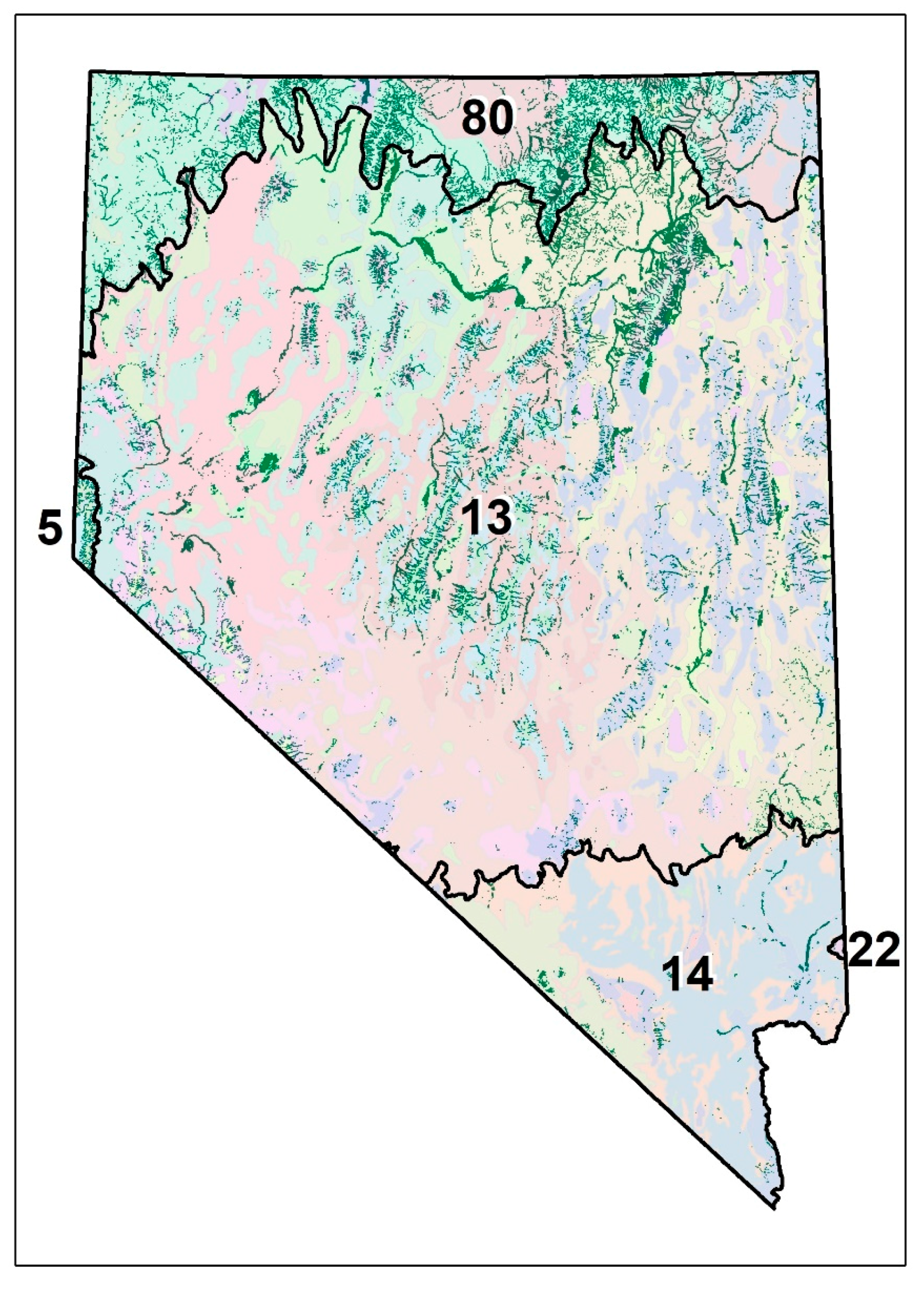
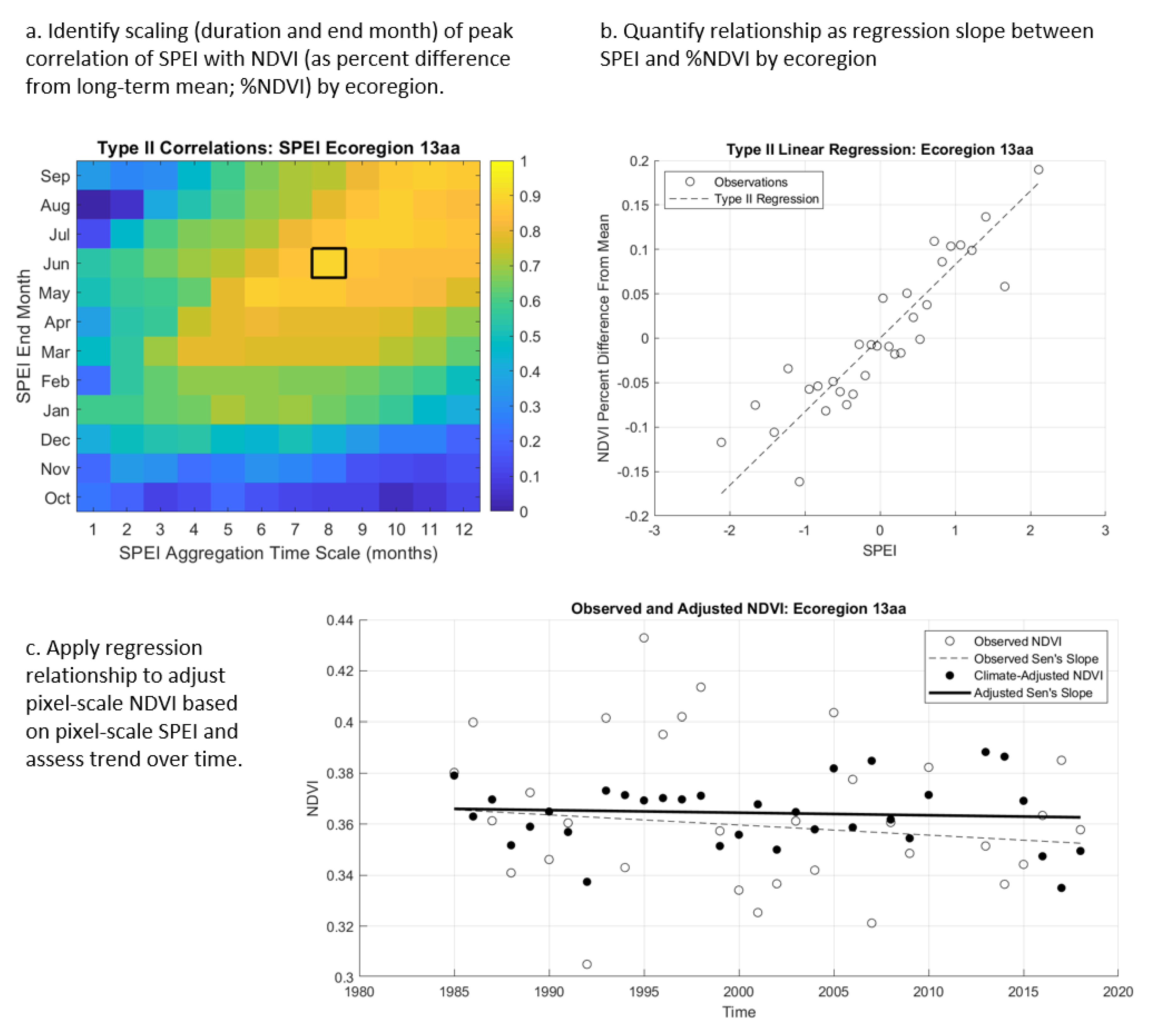
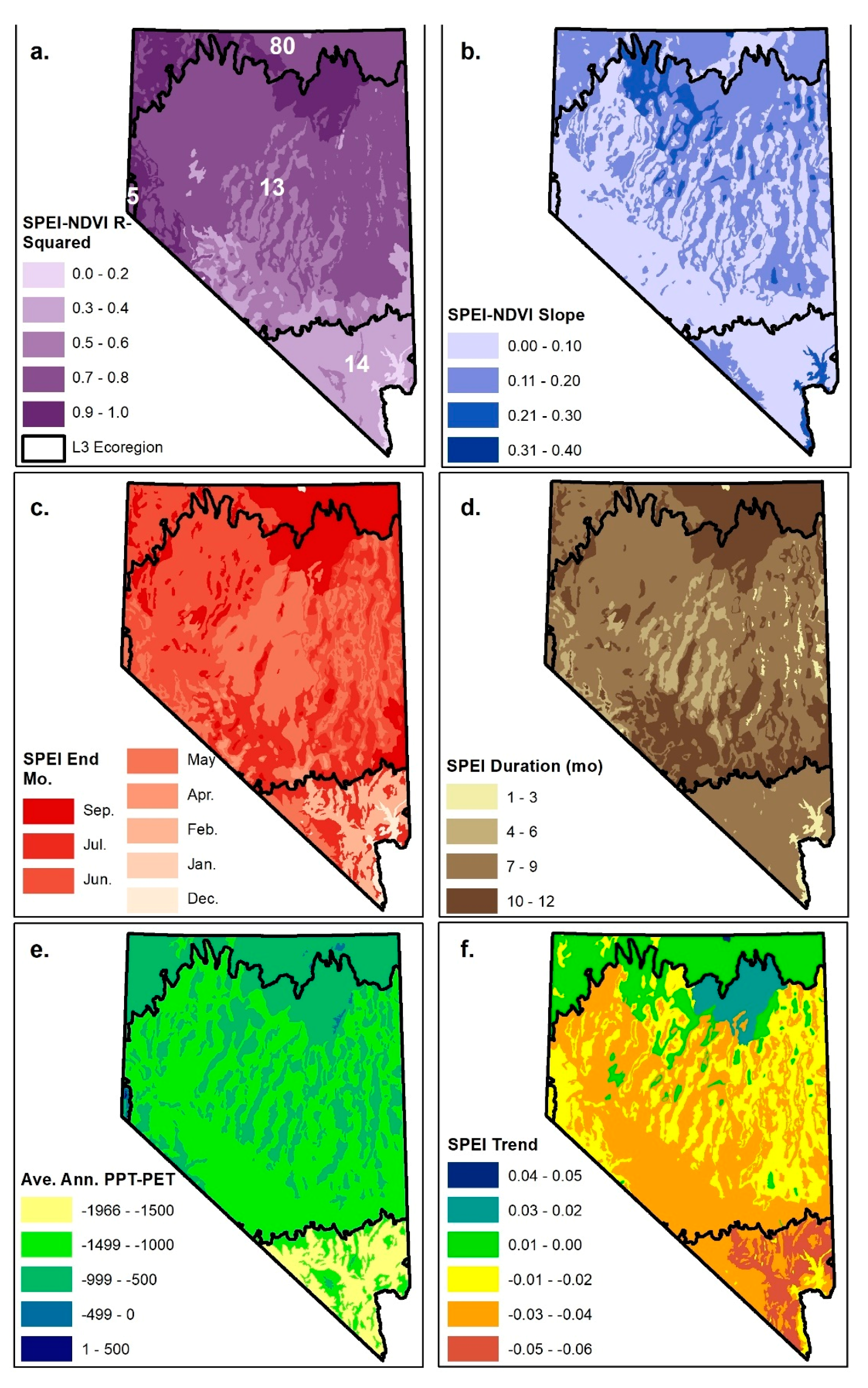
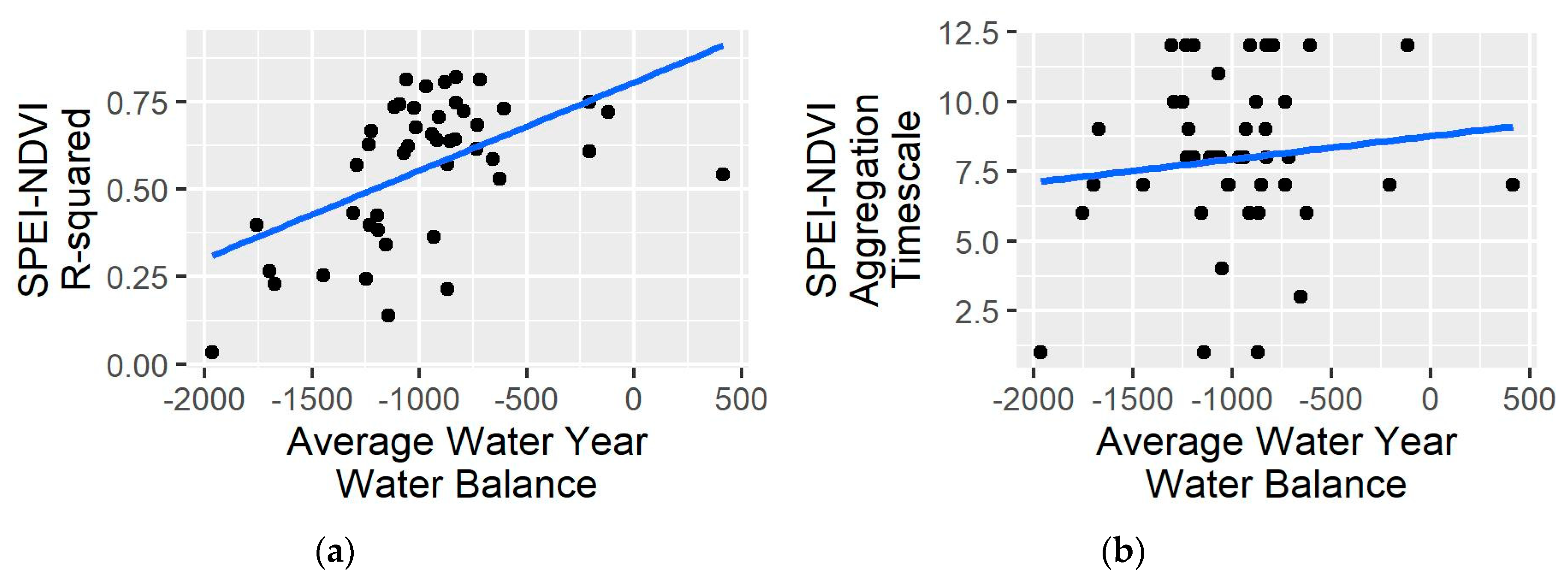
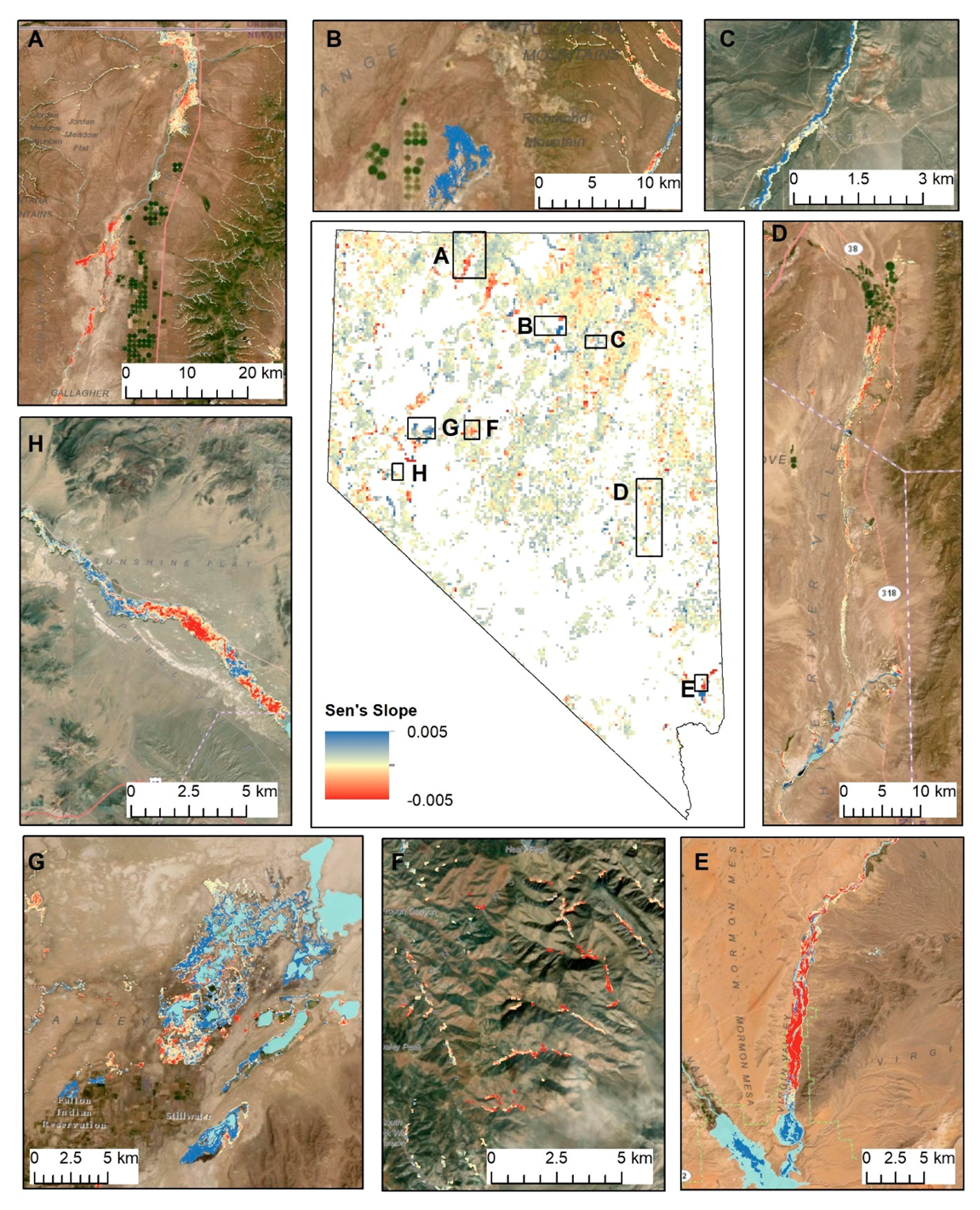
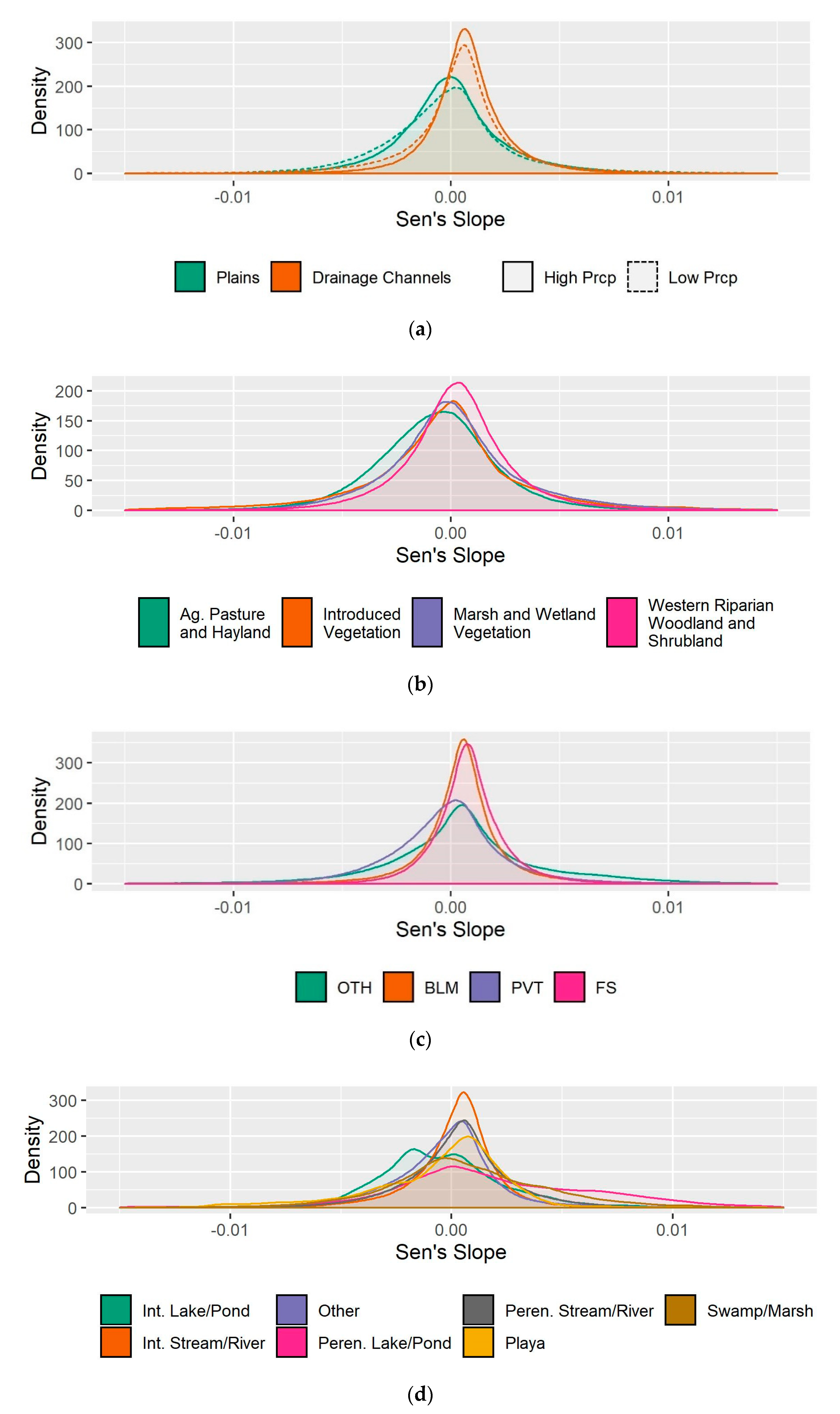
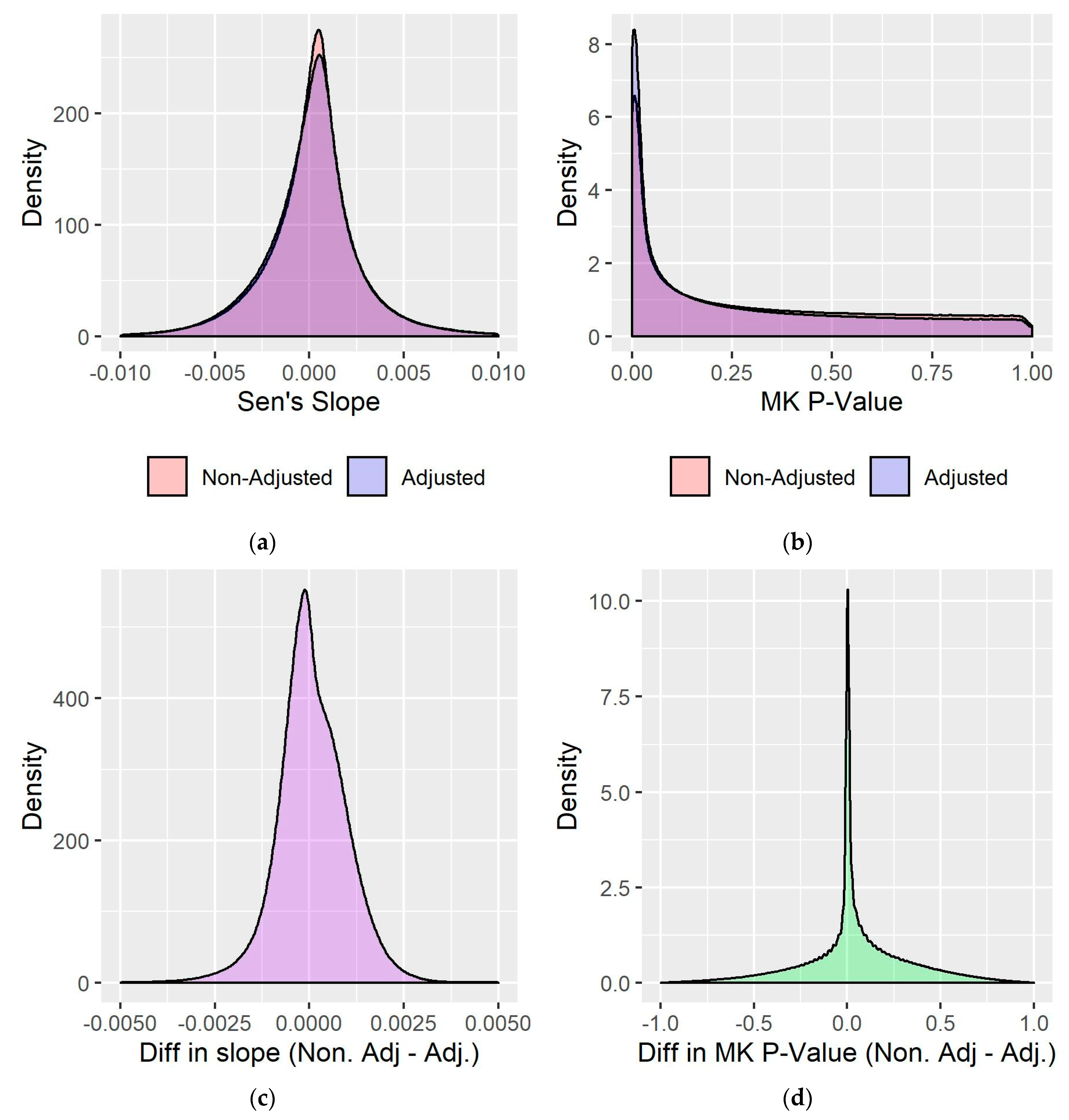
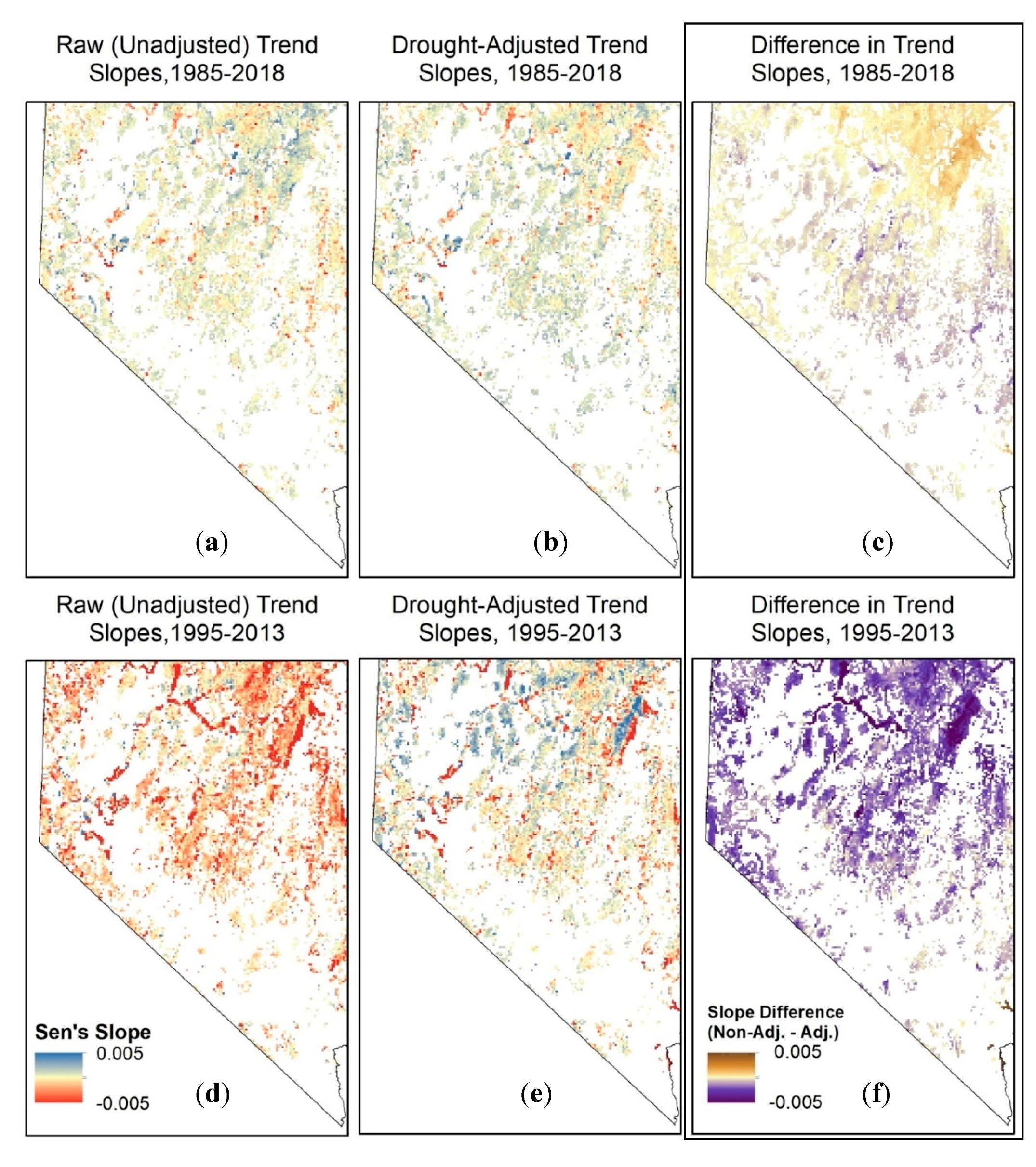
| L4 Eco. Name. | L4 Eco. Code | L4 Eco. Riparian Area (sq km) | Ave. Annual Water Balance (mm) | SPEI Start Month | SPEI End Month | SPEI Duration (months) | SPEI-NDVI Slope | SPEI- NDVI R2 | SPEI Trend Slope |
|---|---|---|---|---|---|---|---|---|---|
| Central Basin and Range | |||||||||
| Salt Deserts | 13a | 25.68 | −940 | Dec. | Jul. | 8 | 0.22 | 0.66 | 0.014 |
| Sierra Nevada-Influenced Semiarid Hills and Basins | 13aa | 48.64 | −1062 | Nov. | Jun. | 8 | 0.08 | 0.81 | −0.017 |
| Upper Owens Valley | 13ac | 0.02 | −1145 | Apr. | May | 1 | 0.17 | 0.14 | 0.008 |
| Shadscale-Dominated Saline Basins | 13b | 161.32 | −1070 | Sept. | Jul. | 11 | 0.15 | 0.60 | −0.013 |
| Sagebrush Basins and Slopes | 13c | 25.90 | −1050 | Apr. | Jul. | 4 | 0.08 | 0.62 | −0.012 |
| Woodland- and Shrub-Covered Low Mountains | 13d | 26.92 | −1192 | Oct. | Sep. | 12 | 0.06 | 0.38 | −0.038 |
| High Elevation Carbonate Mountains | 13e | 12.20 | −657 | Apr. | Jun. | 3 | 0.06 | 0.59 | −0.019 |
| Wetlands | 13g | 116.39 | −1154 | Dec. | May | 6 | 0.16 | 0.34 | 0.008 |
| Lahontan and Tonopah Playas | 13h | 62.71 | −1233 | Oct. | Sep. | 12 | 0.12 | 0.63 | −0.032 |
| Lahontan Salt Shrub Basin | 13j | 175.54 | −1222 | Oct. | Jun. | 9 | 0.08 | 0.67 | −0.020 |
| Lahontan Sagebrush Slopes | 13k | 96.27 | −967 | Nov. | Jun. | 8 | 0.12 | 0.79 | −0.001 |
| Lahontan Uplands | 13l | 52.53 | −833 | Jan. | Sep. | 9 | 0.08 | 0.64 | −0.020 |
| Upper Humboldt Plains | 13m | 746.23 | −879 | Dec. | Sep. | 10 | 0.15 | 0.81 | 0.027 |
| Mid-Elevation Ruby Mountains | 13n | 92.51 | −717 | Dec. | Jul. | 8 | 0.13 | 0.81 | 0.019 |
| High Elevation Ruby Mountains | 13o | 2.51 | −209 | Dec. | Jun. | 7 | 0.09 | 0.75 | 0.018 |
| Carbonate Sagebrush Valleys | 13p | 323.98 | −1016 | Dec. | Jun. | 7 | 0.16 | 0.68 | −0.003 |
| Carbonate Woodland Zone | 13q | 93.86 | −855 | Nov. | May | 7 | 0.07 | 0.64 | −0.024 |
| Central Nevada High Valleys | 13r | 226.36 | −1023 | Nov. | May | 7 | 0.14 | 0.73 | −0.026 |
| Central Nevada Mid-Slope Woodland and Brushland | 13s | 118.65 | −868 | Dec. | May | 6 | 0.08 | 0.57 | −0.012 |
| Central Nevada Bald Mountains | 13t | 44.31 | −627 | Dec. | May | 6 | 0.08 | 0.53 | −0.006 |
| Tonopah Basin | 13u | 44.31 | −1292 | Oct. | Jul. | 10 | 0.10 | 0.57 | −0.028 |
| Tonopah Sagebrush Foothills | 13v | 5.99 | −1229 | Oct. | May | 8 | 0.08 | 0.40 | −0.030 |
| Tonopah Uplands | 13w | 6.99 | −1248 | Jul. | Apr. | 10 | 0.07 | 0.24 | −0.037 |
| Sierra Nevada-Influenced Ranges | 13x | 43.23 | −915 | Dec. | May | 6 | 0.06 | 0.64 | −0.005 |
| Sierra Nevada-Influenced High Elevation Mountains | 13y | 10.02 | −735 | Sep. | Jun. | 10 | 0.06 | 0.62 | −0.024 |
| Upper Lahontan Basin | 13z | 475.00 | −1114 | Nov. | Jun. | 8 | 0.24 | 0.74 | 0.005 |
| Mojave Basin and Range | |||||||||
| Eastern Mojave Basins | 14a | 11.01 | −1673 | Jun. | Feb. | 9 | 0.08 | 0.23 | −0.044 |
| Eastern Mojave Low Ranges and Arid Footslopes | 14b | 18.38 | −1447 | Jan. | Jul. | 7 | 0.08 | 0.25 | −0.028 |
| Eastern Mojave Mountain Woodland and Shrubland | 14c | 1.69 | −1194 | Dec. | Jul. | 8 | 0.06 | 0.42 | −0.020 |
| Eastern Mojave High Elevation Mountains | 14d | 0.07 | −933 | Nov. | Jul. | 9 | 0.04 | 0.36 | −0.024 |
| Arid Valleys and Canyonlands | 14e | 40.07 | −1966 | Nov. | Dec. | 1 | 0.27 | 0.03 | −0.012 |
| Mojave Playas | 14f | 1.26 | −1756 | Aug. | Jan. | 6 | 0.10 | 0.40 | −0.011 |
| Amargosa Desert | 14g | 20.54 | −1697 | Nov. | May | 7 | 0.12 | 0.27 | −0.026 |
| Arizona/New Mexico Plateau | |||||||||
| Middle Elevation Mountains1 | 22d | 0.33 | −1307 | Oct. | Sep. | 12 | 0.06 | 0.43 | −0.033 |
| Sierra Nevada | |||||||||
| Northern Sierra Subalpine Forests | 5b | 0.32 | 413 | Nov. | May | 7 | 0.06 | 0.54 | −0.011 |
| Northern Sierra Upper Montane Forests | 5c | 7.58 | −208 | Nov. | May | 7 | 0.04 | 0.61 | −0.006 |
| Northeastern Sierra Mixed Conifer-Pine Forests | 5f | 21.92 | −731 | Nov. | May | 7 | 0.04 | 0.68 | −0.004 |
| Northern Basin and Range | |||||||||
| Dissected High Lava Plateau | 80a | 297.02 | −830 | Oct. | Sep. | 12 | 0.16 | 0.75 | 0.018 |
| Semiarid Hills and Low Mountains | 80b | 24.84 | −795 | Oct. | Sep. | 12 | 0.12 | 0.72 | 0.014 |
| Pluvial Lake Basins | 80d | 9.84 | −908 | Oct. | Sep. | 12 | 0.18 | 0.71 | −0.010 |
| High Desert Wetlands | 80e | 1.37 | −871 | Nov. | Dec. | 1 | 0.37 | 0.22 | 0.040 |
| High Lava Plains | 80g | 222.71 | −828 | Nov. | Jun. | 8 | 0.12 | 0.82 | 0.004 |
| Semiarid Uplands | 80j | 269.58 | −606 | Oct. | Sep. | 12 | 0.10 | 0.73 | 0.007 |
| Partly Forested Mountains | 80k | 4.16 | −119 | Oct. | Sep. | 12 | 0.08 | 0.72 | 0.013 |
| Salt Shrub Valleys | 80l | 51.19 | −1092 | Nov. | Jun. | 8 | 0.17 | 0.74 | −0.005 |
| Mean | Median | Standard Deviation | ||
|---|---|---|---|---|
| Landfire Vegetation Group Type | Agricultural Pasture and Hayland | −0.00073 | −0.00066 | 0.0029 |
| Introduced Vegetation | −0.00032 | −0.00021 | 0.0038 | |
| Marsh and Wetland Vegetation | 0.00013 | −0.00005 | 0.0032 | |
| Western Riparian Woodland and Shrubland | 0.00028 | 0.00027 | 0.0027 | |
| National Hydrographic Dataset Water Type | Int. Lake/Pond | −0.00038 | −0.00063 | 0.0030 |
| Int. Stream/River | 0.00018 | 0.00036 | 0.0021 | |
| Other | −0.00030 | −0.00010 | 0.0027 | |
| Peren. Lake/Pond | 0.00182 | 0.00126 | 0.0047 | |
| Peren. Stream/River | 0.00028 | 0.00038 | 0.0027 | |
| Playa | −0.00054 | 0.00014 | 0.0034 | |
| Swamp/Marsh | 0.00064 | 0.00038 | 0.0038 | |
| Land Ownership | Other | 0.00058 | 0.00047 | 0.0038 |
| Bureau of Land Management | 0.00049 | 0.00053 | 0.0022 | |
| Private | −0.00020 | −0.00011 | 0.0028 | |
| US Forest Service | 0.00083 | 0.00078 | 0.0018 | |
| Landform and Climate | Plains/High Prcp | −0.00002 | −0.00008 | 0.0025 |
| Plains/Low Prcp | −0.00024 | −0.00020 | 0.0031 | |
| Drainage Channels/High Prcp | 0.00076 | 0.00069 | 0.0020 | |
| Drainage Channels/Low Prcp | 0.00039 | 0.00050 | 0.0027 |
© 2020 by the authors. Licensee MDPI, Basel, Switzerland. This article is an open access article distributed under the terms and conditions of the Creative Commons Attribution (CC BY) license (http://creativecommons.org/licenses/by/4.0/).
Share and Cite
Albano, C.M.; McGwire, K.C.; Hausner, M.B.; McEvoy, D.J.; Morton, C.G.; Huntington, J.L. Drought Sensitivity and Trends of Riparian Vegetation Vigor in Nevada, USA (1985–2018). Remote Sens. 2020, 12, 1362. https://doi.org/10.3390/rs12091362
Albano CM, McGwire KC, Hausner MB, McEvoy DJ, Morton CG, Huntington JL. Drought Sensitivity and Trends of Riparian Vegetation Vigor in Nevada, USA (1985–2018). Remote Sensing. 2020; 12(9):1362. https://doi.org/10.3390/rs12091362
Chicago/Turabian StyleAlbano, Christine M., Kenneth C. McGwire, Mark B. Hausner, Daniel J. McEvoy, Charles G. Morton, and Justin L. Huntington. 2020. "Drought Sensitivity and Trends of Riparian Vegetation Vigor in Nevada, USA (1985–2018)" Remote Sensing 12, no. 9: 1362. https://doi.org/10.3390/rs12091362
APA StyleAlbano, C. M., McGwire, K. C., Hausner, M. B., McEvoy, D. J., Morton, C. G., & Huntington, J. L. (2020). Drought Sensitivity and Trends of Riparian Vegetation Vigor in Nevada, USA (1985–2018). Remote Sensing, 12(9), 1362. https://doi.org/10.3390/rs12091362





